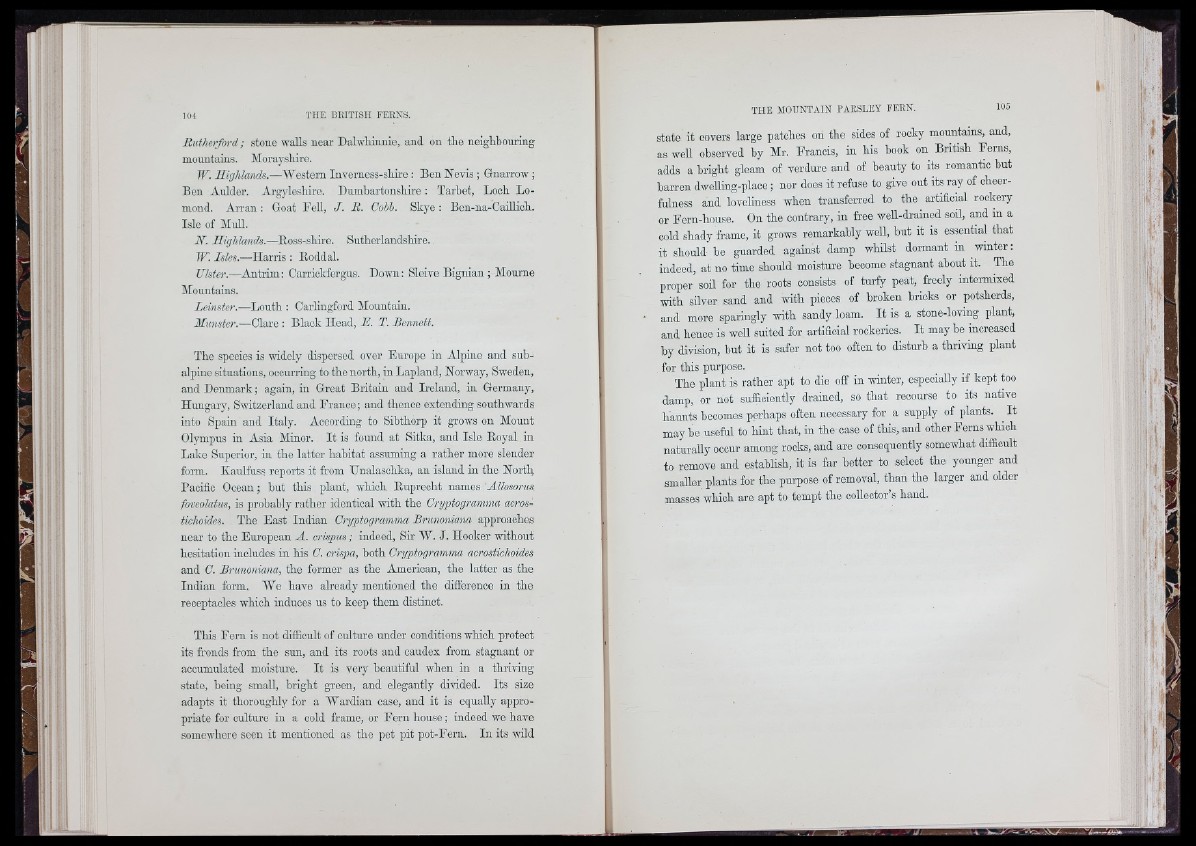
104 THE BlìITISH FERNS.
Buthej'ford; stone walls near Dalwhinnie, and on the neighbouring
mountains. Moraj’shire.
W. Ilighlands.—IVestern Inverness-shire : Bon Nevis; Gnarrow;
Ben Aulder. Argylcshire. Dumbartonshire: Tarbot, Looh Lomond.
Arran : Goat Foil, J . B. Cobb. Skye : Ben-na-Caillich.
Isle of Mull.
N. Highlands.—Eoss-shire. Sutherlandshire.,
IF. Isles.—Harris : Eoddal.
TJlster.—Antrim: Carrickforgus. Down: Sleive Bignian ; Mourne
Mountains.
Leinster.—Louth : Carlingford Mountain.
Munster.—Clare : Black Head, J?. T. Bennett.
The species is widely dispersed over Europe in Alpine and subalpine
situations, occurring to tho north, in Lapland, Norway, Sweden,
and Denmark ; again, in Great Britain and Ireland, in Germany,
Hungary, Switzerland and France; and thence extending southwards
into Spain and Italy. According to Sibthorp it grows on Mount
Olympus in Asia Minor. I t is found at Sitka, and Isle Eoyal in
Lake Superior, in the latter habitat assuming a rather more slender
form. Kaulfuss reports it from Unalaschka, an island in the North
Pacific Ocean ; hut this plant, which Eupreoht names 'Allosorus
foveolatus, is probably rather identical with the Cryptogramma acros-
tichoides. The East Indian Cryptogramma Brimoniana approaches
near to the European A . crispus; indeed, Sir IV. J. Hooker without
hesitation includes in his C. crispa, both Cryptogramma aorostichoides
and C. Brunoniana, the former as the American, the latter as the
Indian form. IVe have already mentioned the difference in the
receptacles which induces us to keep them distinct.
This Fern is not difficult of culture under conditions which protect
its fronds from the sun, and its roots and caudex from stagnant or
accumulated moisture. I t is very beautiful when in a thriving
state, boing small, bright green, and elegantly divided. Its size
adapts it thoroughly for a Wardian case, and it is equally appropriate
for culture in a cold frame, or Forn house; indeed we have
somewhere seen it mentioned as the pet pit pot-Forn. In its wild
state it covers large patches on the sides of rocky mountains, and,
as well observed by Mr. Francis, in Ms book on British Ferns,
adds a bright gleam of verdure and of beauty to its romantic but
barren dwoUing-placo ; nor does it refuse to give out its ray of cheerfulness
and loveliness when transferred to the artificial rockery
or Fern-house. On the contrary, in free weU-drained soil, and in a
cold shady frame, it grows remarkably well, but it is essential that
it should he guarded against damp whilst dormant in winter:
indeed, at no time should moisture become stagnant about it. The
proper soil for the roots consists of turfy peat, freely intermixed
with silver sand and with pieces of broken bricks or potsherds,
and more sparingly with sandy loam. I t is a stone-loving plant,
and hence is well suited for artificial rookeries. I t may he increased
by division, but it is safer not too often to disturb a tbriving plant
for this purpose.
The plant is rather apt to die off in winter, especiaUy if kept too
damp, or not sufficiently drained, so that recourse to its native
haunts becomes perhaps often necessary for a supply of plants. I t
may he useful to hint that, in the case of this, and other Ferns which
naturaUy occur among rooks, and aro consequently somewhat difficult
to remove and establish, it is far better to select tbe younger and
smaUer plants for tbe purpose of removal, than the larger and older
masses which are apt to tempt the collector’s hand.
mm
I
iM
t ' - I
'7 1
I II
! '
' 'M